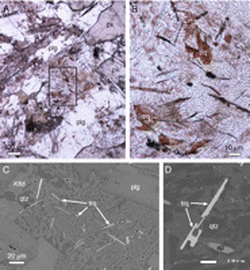January 5, 2012 report
Third lunar mineral - Tranquillityite found in Western Australia

(PhysOrg.com) -- Back in the heyday of the Apollo moon program, hundreds of pounds of rock samples were carted back to Earth by visiting astronauts. Those samples were then pored over more thoroughly by geologists than perhaps any other rocks in human history, and after all that study, three minerals were found that were unique to the moon: armalcolite, pyroxferroite and tranquillityite. The first two were subsequently found over the next ten years on the surface of the Earth as well, but the third, named after Tranquility Base, site of the first moon landing, had never been found here on this planet, at least not naturally, tranquillityite has been found in meteorite samples. But now that’s changed.
Birger Rasmussen, paleontologist with Curtin University in Perth, and colleagues have found natural samples in several sites in Western Australia, and as they describe in their paper published in Geology, it appears likely the mineral is more common here on our home planet than anyone might have surmised.
The mineral has been found in six sites in all, in various remote spots in Western Australia, and occurs in very small amounts. The samples found were actually about the width of a human hair and just microns in length, and that’s part of the reason why it’s taken so long for those that study rocks to find such samples here on Earth. Another reason is that tranquillityite is comparatively delicate and tends to break down when exposed to normal surface climatic events such as heat, rain and wind.
Rasmussen notes that the team had been studying the lunar samples recently and so when they came across some interesting rocks while digging around for other reasons, it seemed logical that they might have at least some traces of the rare mineral. To find out, they subjected the sample to a blast of electrons; a method researchers use to identify certain materials. The trajectories produced by the blast are unique for each mineral. In so doing, they found a perfect match with the lunar samples.
Tranquillityite is made up of iron, silicon, oxygen, zirconium, titanium and a tiny bit of yttrium, a rare earth element, and though it doesn’t have appear to have much in the way of economical value, it can be used by researchers to deduce the age of other rocks in which it is embedded.
Another possible reason for the long time lag in finding tranquillityite here on Earth is that it takes a very special unique set of conditions for it to form. Plus, there’s the fact that it appears no one has really been trying very hard to find it. Thus, now that it’s been found in six widely scattered spots, it’s likely that it’s not nearly as rare as many in the geology field had thought.
More information: Tranquillityite: The last lunar mineral comes down to Earth, Geology, v. 40 no. 1 p. 83-86. First published online November 23, 2011, doi: 10.1130/G32525.1
Abstract
Tranquillityite [Fe2+8(ZrY)2Ti3Si3O24] was first discovered in mare basalts collected during the Apollo 11 lunar mission to the Sea of Tranquillity. The mineral has since been found exclusively in returned lunar samples and lunar meteorites, with no terrestrial counterpart. We have now identified tranquillityite in six dolerite dikes and sills from Western Australia. Terrestrial tranquillityite commonly occurs as clusters of fox-red laths closely associated with baddeleyite and zirconolite in quartz and K-feldspar intergrowths in late-stage interstices between plagioclase and pyroxene. Its composition is relatively uniform, comprising mostly Si, Zr, Ti, and Fe, with minor Al, Mg, Mn, Ca, Nb, Hf, Y, and rare earth elements. Its habit and chemistry are consistent with tranquillityite in lunar basalts, and it has a face-centered-cubic subcell, similar to that of annealed lunar tranquillityite. Unlike coexisting baddeleyite and zirconolite, it is commonly altered to a secondary intergrowth of submicron phases comprising mainly Si, Ti, and Ca, with minor Zr. In situ sensitive high-resolution ion microprobe (SHRIMP) U-Pb geochronology of tranquillityite from sills intruding the Eel Creek Formation, northeastern Pilbara Craton, yields a 207Pb/206Pb age of 1064 ± 14 Ma. This age indicates that the previously undated sills belong to the ca. 1070 Ma Warakurna large igneous province, extending the geographic range of this mafic complex. The date also provides a new minimum age (>1.05 Ga) for the intruded sedimentary rocks, which were previously thought to be Neoproterozoic. Examination of dolerite from Western Australia suggests that tranquillityite is a relatively widespread, albeit volumetrically minor, accessory mineral and, where sufficiently coarse, it represents an exceptional new U-Pb geochronometer.
Journal information: Geology
© 2011 PhysOrg.com



















